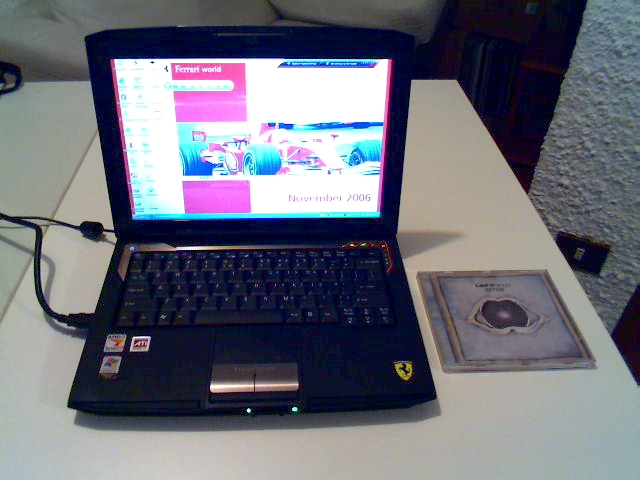
Talk about massive.
I saw this at the Monaco Press Conference and it is a seriously-enormous piece of equipment. Massive in scale and massive in spec, and now there's the Core 2 Duo version (9810) it packs an even bigger punch. I've read several sites saying it's a notebook strapped onto one of Acer's 20" screens and that's not too far away from the truth.
Before I go into (a little) detail, there seems to be a common perception of this multimedia giant as a desktop replacement, while Acer has gone its own way, putting it squarely in the Home Entertainment camp.
First let's clear this up. Acer has split its not inconsiderable range of notebooks into four functional groups:
1. Desktop Replacement - for corporate & medium-sized companies who need to replace their networked/managed corporate desktops with stylish, compact and reliable all-in-one notebooks that offer all the power, security and flexibility of a desktop PC, while providing maximum productivity, enhanced manageability and complete connectivity. The corporate user has different mobility needs, so this group includes normal notebooks, ultra-portables with docking ability and Tablet PCs.
2. Mobility at work - for corporate & medium-sized companies who need powerful and efficient mobile solutions that comply to company rules and management standards. They have different mobility needs, so this group includes both normal notebooks and ultra-portables. This group also includes a sub segment for tablet users, who need mobility and versatility.
3. Small Office Home Office solutions - for users who typically use their notebook both professionally and privately. Consequently, these solutions support professional work as well as entertainment, featuring both professional connectivity and solid audio/video functionalities.
4. Home Entertainment - for private buyers looking for an affordable solution for home entertainment and infotainment that offers high audio/video capabilities and a friendly price-tag. The high-end function group offers rich multimedia features, whereas the entry level solutions feature basic entertainment features.
Notice that Desktop Replacement is clearly targeted towards the business end of the spectrum, while the 9800 series fits squarely in the Home Entertainment group. If anyone should know which mobile solution belongs to which functional group, it's Acer.
So it's designed for Home Entertainment and if you've got the room, there's very little else that can pack so much entertainment into such a (relatively) small space.
I mean, even in storage terms, the spec sheet talks of two, 120 GB Serial ATA drives that support RAID 0, 1 and Intel Matrix RAID meaning you get superior data protection plus this new fangled technology from Intel that allocates a safe storage area for important data alongside a faster area for the operating system and other applications. Fast and secure then.
Then there's that monitor. Take a look at the specs: 20.1" WSXGA+ high-brightness (300-nit) Acer CrystalBrite™ TFT LCD, 1680 x 1050 pixel resolution, 6 lamps. Now that's big and bright. Naturally if that weren't enough, you can always hook up another external monitor and double the impact, as if you'd really need to...
Screen size apart, what I really love about this notebook (and all Acer notebooks with this technology) is GridVista. GridVista automatically splits the screen up into semi-equal parts (depending on your chosen number of divisions) and is one of those technologies you don't really think about until you have to work on an application intensive project on another PC. Boy is this a clever invention! Thing is on the 9800, the screen is so large you can split it up into 8 sections. Which means that, technically, with two screens you could have 16 applications open at the same time and see and use every one of them. Wicked.
I won't go into the HD DVD argument just yet as I haven't been able to test it first hand and as far as I'm concerned, it's not exactly the ideal storage solution as I'm sure blank HD DVDs will cost more per GB than, say, an external hard drive but more of that later.
The 9800 is massive no doubt about it. We're talking 105/6-key keyboard with room to spare. But if you're looking for something that does pretty much everything (digital TV included) on a massive scale and doesn't look like a relic from the office, this is definitely it.
PS Get the optional Acer Bluetooth® VoIP phone. Trust me, your back will love you for it.
















